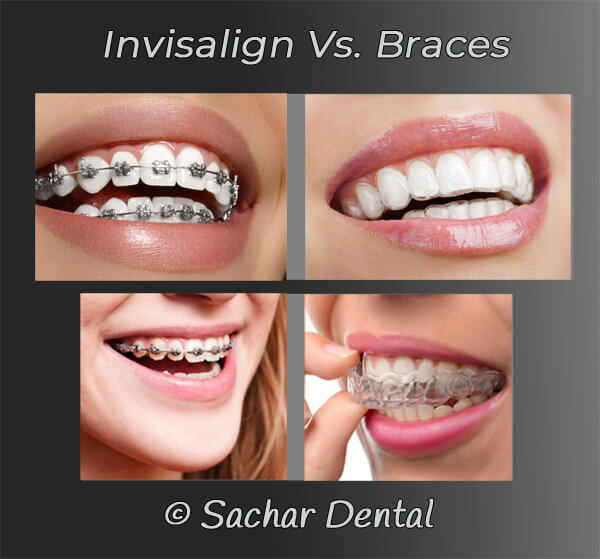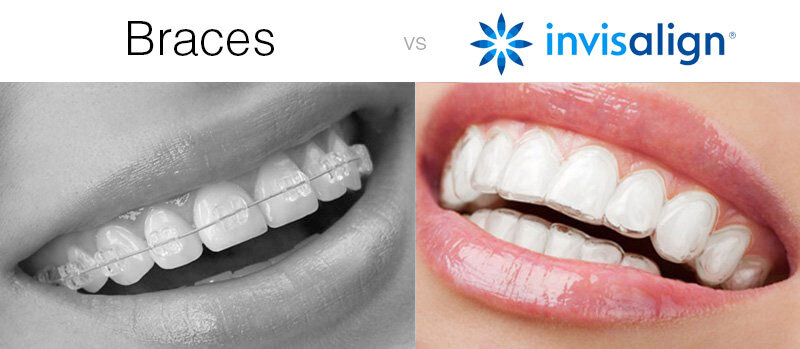How Invisalign Functions: Your Overview to Clear Aligners and Their Effectiveness
How Invisalign Functions: Your Overview to Clear Aligners and Their Effectiveness
Blog Article
Invisalign vs. Traditional Braces: Which Choice Is Right for You?
When taking into consideration orthodontic therapy, the option between Invisalign and conventional braces offers numerous crucial elements that merit mindful analysis. Invisalign uses a discreet alternative with detachable aligners, while standard braces provide an extra noticeable yet effective solution for extreme misalignment.
Overview of Therapy Choices

On the other hand, standard dental braces contain metal braces and wires that are bonded to the teeth. This method uses constant pressure in time to attain positioning. While effective for complicated orthodontic concerns, traditional braces call for regular sees for adjustments and can position difficulties in keeping dental health due to the problem of cleaning up about braces and cords.
Both options have their advantages, and the selection usually depends upon specific dental conditions, way of life preferences, and client conformity. Eventually, getting in touch with an orthodontic specialist is crucial for figuring out one of the most appropriate treatment plan tailored to private requirements. Comprehending the nuances of each option can considerably influence the general success of orthodontic therapy.
Aesthetic Considerations
A significant factor affecting the selection in between Invisalign and typical dental braces is the visual charm each treatment offers. Invisalign aligners are crafted from clear plastic, making them practically unnoticeable when worn. This discreet look is specifically attracting adults and teenagers that may really feel awkward regarding their orthodontic treatment. The ability to keep an all-natural smile throughout the positioning process can significantly boost the individual's confidence in social and professional settings.
On the other hand, typical braces contain metal braces and cables, which can be more obvious. While developments in orthodontic modern technology have brought about the development of smaller braces and colored elastics, standard braces still preserve an even more noticeable account. For some individuals, the exposure of dental braces may hinder them from seeking required treatment.
Ultimately, the choice between Invisalign and traditional dental braces might pivot on personal choices pertaining to visual appeals. Individuals who prioritize discernment often lean toward Invisalign, while those who are less worried concerning visibility may select traditional braces. Comprehending the visual implications of each choice is critical for making an informed decision that lines up with one's way of life and choices.
Convenience and Convenience

In regards to comfort, Invisalign aligners are removable, enabling patients to appreciate their preferred foods without restriction and keep optimal oral health. Brushing and flossing are simplified, as the aligners can be obtained throughout these routines, whereas typical dental braces require mindful navigating around brackets and cords.
In contrast, traditional dental braces demand regular changes, making them much less hassle-free for those with busy timetables. Generally, the comfort and comfort of Invisalign make it an enticing choice for several individuals seeking orthodontic therapy.
Therapy Duration and Efficiency
While both Invisalign and typical braces work in dealing with oral misalignments, the duration of therapy can differ significantly between the two alternatives. Typically, Invisalign treatment can take anywhere from 12 to 18 months, relying on the complexity of the case. The clear aligners work read here by slowly changing teeth right into their wanted positions, and regular follow-ups with an orthodontist help make sure development continues to be on course.
In contrast, traditional braces typically call for a longer dedication, generally varying from 18 months to 3 years. This results from their set nature and the usage of braces and cords, which can be extra reliable for extreme imbalances and intricate instances (Invisalign). The treatment efficiency of conventional braces is well-documented, as they permit precise adjustments and greater control over tooth activity
Inevitably, the selection in between Invisalign and conventional braces may rest on both the awaited therapy duration and the particular dental concerns available. Consulting with an orthodontist is vital, as they can supply tailored recommendations based upon private requirements, guaranteeing the chosen approach lines up with preferred durations and results.
Cost Contrast and Insurance Policy Choices
Cost plays a substantial function in the decision-making process for people taking into consideration orthodontic therapy, browse around here whether choosing Invisalign or traditional dental braces. Typically, the cost of Invisalign varieties from $3,000 to $8,000, while conventional dental braces normally cost in between $2,000 and $6,000. Elements affecting these expenses consist of the complexity of the instance, the duration of therapy, and geographical location.
Insurance policy coverage can dramatically affect out-of-pocket expenditures. Numerous oral insurance coverage strategies offer partial insurance coverage for orthodontic treatments, yet the specifics can vary commonly. It is crucial for individuals to review their insurance coverage to identify the level of coverage for either choice. Generally, conventional dental braces might be much more regularly covered by insurance plans contrasted to Invisalign, which some insurance providers classify as an aesthetic procedure.
Additionally, a number of orthodontic techniques offer versatile settlement plans, making More Info both treatment choices extra accessible. Individuals need to ask about possible funding options and price cuts for upfront repayments. Examining the complete price, consisting of insurance policy advantages and settlement strategies, is essential for making an informed decision that aligns with both visual choices and spending plan factors to consider.

Final Thought
In summary, the option between Invisalign and conventional braces hinges on multiple elements, including aesthetic preferences, comfort, treatment duration, and cost. Invisalign supplies a very discreet, removable alternative that promotes dental health and dietary flexibility, while traditional dental braces might be preferable for complex oral concerns and frequently come at a reduced cost point. Ultimately, appointment with an orthodontist is important to examine private circumstances and establish one of the most suitable therapy choice for achieving optimum oral alignment.
When taking into consideration orthodontic treatment, the choice in between Invisalign and conventional dental braces provides several vital elements that merit cautious evaluation.Contrasting Invisalign and conventional dental braces exposes distinct therapy options for orthodontic improvement.While both Invisalign and standard braces are efficient in correcting oral misalignments, the period of treatment can differ substantially in between the two alternatives.Expense plays a substantial function in the decision-making procedure for individuals taking into consideration orthodontic treatment, whether choosing for Invisalign or traditional dental braces.In recap, the choice in between Invisalign and typical braces pivots on multiple aspects, consisting of aesthetic preferences, convenience, therapy duration, and expense.
Report this page